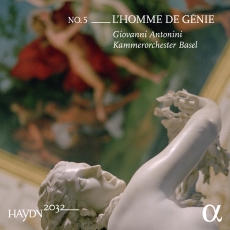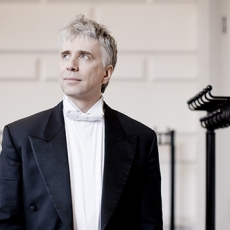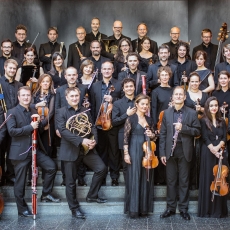Giovanni Antonini & Kammerorchester Basel - Haydn 2032, Vol. 5: L'homme de génie - MusicWeb International
2032, the year of Haydn’s tercentenary seems a long way off. By then, one imagines Iceland will have won the World Cup four successive times, my beloved Accrington Stanley will be European Champions and there will be a new leader of the free world (if the concept still exists). I certainly hope I’m still around then to enjoy these goodies. A substantial bonus will be the completion of Giovanni Antonini’s traversal of Haydn’s complete symphonies (all 107 – gone are the old certainties of one’s youth – nine planets in the Solar System; Hallé concerts at the Free Trade Hall; 104 Haydn symphonies etc). I have found the four previous issues utterly absorbing; No 5 is arguably the best yet.
There has been a change of personnel: as I understand it the Basle Chamber Orchestra are to share responsibilities across the project with Antonini’s Il Giardino Armonico; they sound terrific on period instruments here on this superb disc.. They are a larger band than Il Giardino Armonico and make a bigger noise, which seems most appropriate in the two later Haydn works presented here and especially so in the contemporary (and brilliant) Kraus symphony. Haydn’s Symphonies Nos 80 and 81 were among the last to be recorded on period instruments- indeed, in order to facilitate Decca’s release last year of a complete HIP cycle, Ottavio Dantone conducted the Accademia Bizantia in a double album of Symphonies 78-81 which was used to fill in the gap. (Decca 478 8837) I don’t really understand why some critics were sniffy about these works when the Dantone disc emerged. I remember reading words to the effect of “not prime Papa” on more than one occasion. I thought Dantone’s spirited recordings brought them to life, but I feel that Antonini’s crisp articulation, swift tempi and the fuller sound of the Basle band surpasses them. They also project the essence of these works more directly – Dantone lingers over repeats in each case. (My colleagues Brian Wilson and Dan Morgan mildly disagree – their short review comments can be read here - page 12 in the document). Antonini directs thrilling performances of these, while the recording – utterly consistent despite the use of two different locations – has real bite and detail.
One of the joys of this series to date has been the exceptional presentation: programmes are well-judged and offer works by contemporaries which provide some context for or connection to the Haydn works. The imaginative couplings on previous issues have included lesser-known works by Gluck, W F Bach and Cimarosa; here it is the masterful C minor symphony of Johann Martin Kraus, an almost exact contemporary of Mozart. Antonini here surely provides its best ever recording. In the conductor’s brief but thought-provoking introductory essay, he considers the role of irony in supposedly serious ‘minor-key’ pieces of music of the late 18th century, epitomised by Haydn’s Symphony no 80. At the time certain critics – Johann Adam Hiller is the example cited – considered this practice an affront to good taste. The opening Allegro Spiritoso illustrates the point perfectly in five wonderful minutes of music making. After a dramatic Sturm-driven opening, played with real freshness and vigour by this band, Haydn cheekily cheapens the mood by introducing what amounts to a drinking song - it’s actually a ländler. Antonini presents this idea in best Les Dawson deadpan style, accentuating the effect. The silences which punctuate the phrases are slightly elongated. What contemporary audiences must have made of these ambiguities is anybody’s guess, but one suspects Haydn would have been crying with barely suppressed hysterical laughter into his handkerchief. While the two central movements are more conventional, the joviality returns in the Presto finale, with Haydn disguising the syncopated opening. Again Antonini plays the game by drawing as little attention to this ‘joke’ as possible. This is a brilliant, refreshing reading of a Haydn symphony that is too little known.
After a spirited performance of the even more obscure Symphony No 81, the highlights of which in this performance are the beguiling, elegantly-made Andante, a theme and variations on a Siciliano-type theme; and a crisply-performed, repeated note Allegretto Minuet and Trio, Antonini offers the example of Kraus’s work, an urgent, serious symphony by way of contrast. This work has been described by some as the best symphony of the period not authored by either Haydn or Mozart – although it was at one time attributed to the latter master. Antonini effortlessly draws out the bleakness of its melancholy Larghettoopening, his Basle players fully attuned to its quasi-tragic implications, before launching into the dramatic,(and truly Mozartian, Allegro proper. This is a superb account, the recording rich and detailed – note the beautifully ripe woodwinds at 2’40 in the winsome central Andante. Antonini truly does this somewhat neglected masterpiece justice. The relish in the playing throughout is palpable.
The disc ends with the Haydn’s early Symphony No 19. A slighter, three-movememt construction, it may be less consequential than its siblings on this disc, but it’s still recognisably Haydn and it inevitably has its moments. Nor do Antonini and his players approach it as a makeweight. The spring-loaded fanfare like opening is splendidly achieved, while the slightly -reduced group used in this work are beautifully balanced in the sound picture. The minor key Andante that follows is disarming and prone to moments of reflection and sadness, while the brief concluding Presto is contrastingly skittish and playful.
Having referred to Alpha’s de-luxe production standards throughout this series, it would be remiss of me not to mention the sumptuously apt photographs by Stuart Franklin that adorn this desirable release. Those readers who aren’t photography buffs may not recognise his name but they will almost certainly be familiar with his most famous image, that of a student protester obstructing a tank during the Tiananmen Square protests of 1989. His images here are very different – and memorable for completely different reasons. They seal the deal on a magnificent disc. Roll on Volume 6!


